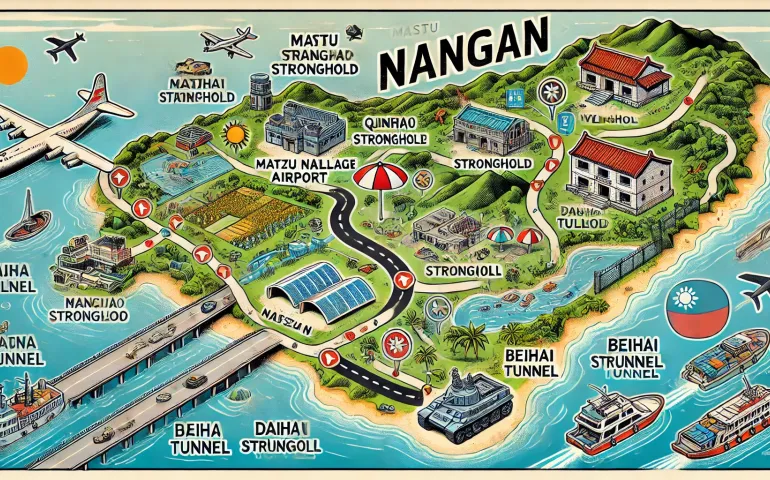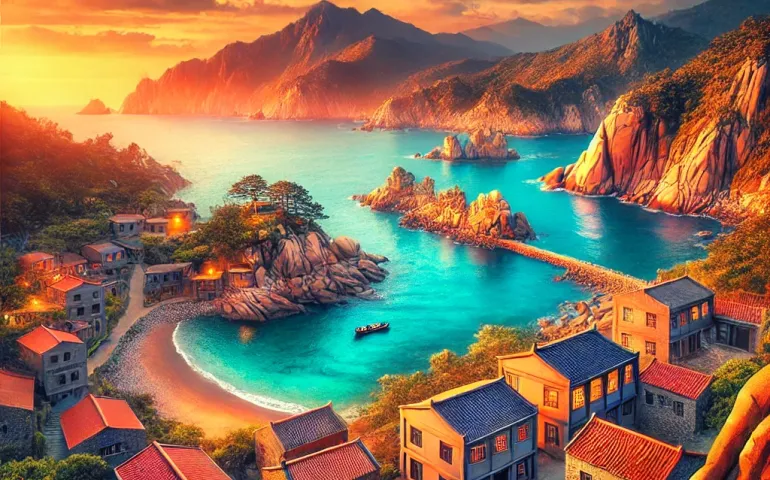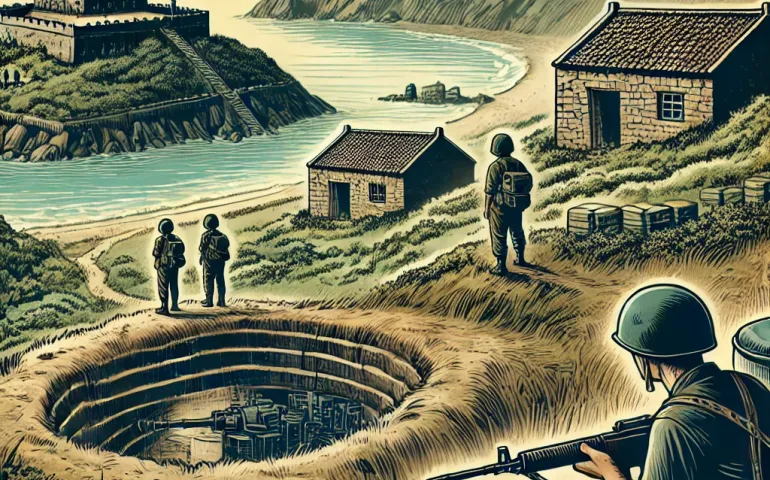About Place
- Historical Significance : Nangan has been a strategic military outpost since ancient times, and this legacy is evident in its numerous forts, bunkers, and military tunnels.
- Natural Beauty : Travelers often describe Nangan as "a place where nature meets history," with its pristine beaches, dramatic coastal landscapes, and clear blue waters.
- Cultural Richness : The island is home to traditional Fujian-style villages and temples, offering a glimpse into the local way of life.
Reasons to Visit
- Military Heritage : Nangan’s history as a frontline defense point during the Cold War has left a lasting legacy. The island is dotted with old bunkers, underground tunnels, and military museums that tell the story of its strategic importance. Visiting these sites provides a unique insight into the island's role in cross-strait relations.
- Pristine Nature : Despite its small size, Nangan boasts a wealth of natural attractions. From the breathtaking views at Dahan Stronghold to the serene beaches of Jinsha Village, Nangan offers an escape into nature. Birdwatching, hiking, and enjoying the scenic coastline are some of the popular activities on the island.
- Cultural Immersion : The island's traditional Fujian-style architecture, along with its vibrant festivals like the Matsu Pilgrimage, makes Nangan a rich cultural experience. The island's villages, such as Qinbi Village, with their stone houses and narrow alleys, take visitors back in time to a more traditional way of life.
Visa
- For Travelers from the United States, Canada, Europe, and Australia : A visa is required to enter Taiwan, but visitors can apply for a visa-exempt entry if they are staying for less than 90 days.
- For Travelers from Southeast Asia : Nationals from some Southeast Asian countries may need to apply for an eVisa or a visitor visa, depending on their country of origin.
- For Travelers from China (Mainland) : Mainland Chinese citizens must apply for a special entry permit to visit Nangan as it is under the administration of Taiwan.
Travel Expenses
- Travel to & from Nangan :
- Flights from Taipei to Nangan are operated by Uni Air. A round-trip ticket costs approximately $150 USD per person.
- For a couple, the total cost for flights would be around $300 USD.
- Hotel Cost :
- Average cost for a guesthouse stay in Nangan is around $50-70 USD per night. For a 3-night stay, the total cost for a couple would be approximately $150-210 USD.
- Food Cost :
- Average cost per meal is about $10-15 USD per person. For 6 meals over 3 days, the total food cost would be around $120-180 USD for a couple.
- Activity Cost :
- Entrance fees for attractions like the Matsu Folk Culture Museum and Beihai Tunnel are minimal, around $5-10 USD per person. The total cost for activities would be approximately $40-60 USD for a couple.
- Near Destination Travel Cost :
- Renting a scooter for island exploration costs around $10-15 USD per day. For 3 days, the total cost would be about $30-45 USD.
Total Estimated Budget :
- For a 3-day trip to Nangan for a couple, including flights, accommodation, food, activities, and local transportation, the total estimated budget would be around $650-795 USD.

Best Itinerary
Day 1 : Arrival and Exploration of Nangan Arrive in Nangan in the early morning. After checking into a traditional Fujian-style guesthouse, start your exploration at the Matsu Distillery, where you can learn about the island's famous Kaoliang liquor and sample a few varieties. Enjoy lunch at a local seafood restaurant, trying dishes like steamed fish and stir-fried clams. In the afternoon, visit the Dahan Stronghold, where you can explore military bunkers and enjoy panoramic views of the coastline. End the day with a visit to Beihai Tunnel, an underground tunnel built for military purposes. For dinner, head to a local eatery to try Matsu-style fried rice and other traditional dishes. After dinner, take a stroll along the coast to enjoy the night breeze before retiring to your guesthouse.
Day 2 : Cultural and Historical Exploration Start your day with a visit to the Matsu Folk Culture Museum to learn about the island's history and traditions. Afterward, explore Qinbi Village, a well-preserved stone house village that offers a glimpse into traditional island life. Enjoy lunch at a small village eatery, trying local delicacies such as fish ball soup and oyster omelet. In the afternoon, hike up to the Iron Fort, a historical military site with stunning views of the surrounding islands. Spend the evening at a local teahouse, where you can relax and enjoy the serene atmosphere. For dinner, try the famous Matsu meat dumplings at a local restaurant. Afterward, head to the coast to catch a glimpse of the stunning bioluminescent plankton, known as "Blue Tears," that light up the waters around the island.
Day 3 : Nature and Relaxation On your final day, take a morning hike to Niujiao Shan (Bull Horn Mountain) for breathtaking views of the sunrise over the Taiwan Strait. After the hike, visit the Jinsha Village beach, where you can relax and soak in the sun. For lunch, enjoy a picnic on the beach with local snacks. In the afternoon, visit the Nangan Lighthouse, an iconic landmark that offers panoramic views of the island. Spend the rest of the day at leisure, perhaps renting a bike to explore the island at your own pace. For dinner, dine at a beachfront restaurant, enjoying fresh seafood with a view of the sunset. End your day with a quiet walk along the beach before heading back to your accommodation.

Safety Tips
- Always carry your passport and identification with you.
- Be cautious of strong currents when swimming in the ocean.
- Follow local customs and respect religious sites.
- Stay hydrated, especially during outdoor activities.
- Rent a scooter from reputable providers and wear a helmet.
- Keep your belongings secure, particularly in crowded areas.
- Learn a few basic phrases in Mandarin to help with communication.
- Check the weather forecast before hiking or visiting coastal areas.
- Use sunscreen to protect yourself from the sun, especially during summer.
- Be aware of your surroundings and avoid isolated areas at night.
Flights
- Uni Air: Direct flights from Taipei to Nangan, approximately 1 hour. Estimated cost is $150 USD round trip per person.
Hotels
- Nangan Jingang Hotel : A mid-range hotel with modern amenities and close proximity to major attractions.
- Qinbi Village Guesthouse : Stay in a traditional stone house in the heart of the village.
- Dahan Guesthouse : A budget-friendly option near Dahan Stronghold with basic but comfortable rooms.
- Beihai Hotel : Located near the Beihai Tunnel, offering easy access to historical sites.
- Matsu Blue Tears B&B : A charming bed and breakfast with views of the ocean and close to the beach.
Contacts
- Indian Embassy in Taiwan : +886 2 2720 1680
- Police : 110
- Ambulance : 119
- Firefighters : 119
Country
Closet Airport
- Matsu Nangan Airport (LZN)
Nearest City
- Taipei
Heritage Sites
- Qinbi Village
Airlines
- Uni Air
Currency
- New Taiwan Dollar (NTD)
Languages Spoken
- Mandarin, with some locals speaking Matsu dialect
Real Story
In the early 1950s, during the height of the Cold War, the Matsu Islands, including Nangan, became a frontline in the conflict between the Republic of China (Taiwan) and the People's Republic of China (Mainland China). The Battle of Kuningtou, fought on the nearby island of Kinmen, underscored the strategic importance of these islands. Nangan was heavily fortified, with the construction of bunkers, tunnels, and military outposts designed to protect against potential invasions. The island's residents lived under constant threat, with military drills and air raid sirens becoming a part of daily life. Despite the tense atmosphere, the people of Nangan remained resilient, and the island never fell to enemy forces. Today, the remnants of this era are preserved in the island's museums and historical sites, serving as a poignant reminder of the island's role in the defense of Taiwan.
Cuisine
Nangan's cuisine is a reflection of its coastal environment and cultural heritage. The island is famous for its fresh seafood, with dishes such as steamed fish, stir-fried clams, and oyster omelets being popular among locals and visitors alike. Another local specialty is Kaoliang liquor, a strong distilled spirit made from sorghum that is often enjoyed with meals. Nangan's traditional dishes also include fish ball soup, Matsu-style fried rice, and meat dumplings, all of which showcase the island's Fujianese culinary roots. The food on Nangan is simple but flavorful, often prepared with locally sourced ingredients and seasoned with traditional herbs and spices.

Culture and History
Nangan's culture is deeply influenced by its strategic location and historical significance. The island's residents primarily descend from Fujianese settlers, and the local culture is a blend of Fujian traditions and military influences. Nangan is known for its traditional Fujian-style architecture, with stone houses that have withstood the test of time. The island's temples and religious practices also reflect its strong cultural heritage, with the Matsu faith being particularly prominent.
During the Cold War, Nangan was heavily fortified as a military outpost due to its proximity to mainland China. This has left a significant mark on the island's culture, with many of the residents having served in the military. The presence of military museums, forts, and tunnels on the island serves as a reminder of its tumultuous past. However, despite its military history, Nangan has retained a peaceful and serene atmosphere, making it an ideal destination for travelers looking to explore a lesser-known part of Taiwan.
